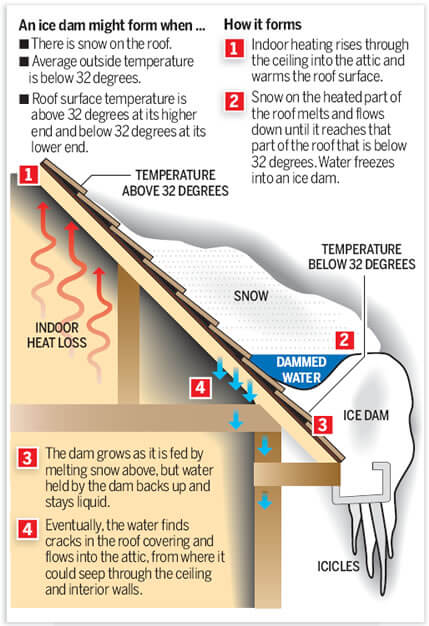All About Ice Dams
From the depths of winter to early spring, ice dams are a frequent sight along roof edges in Massachusetts. Here are some answers to the most frequently asked questions we hear about them.

What is an Ice Dam?
An ice dam accumulates ice at the roof’s edge, causing water to pool behind it rather than flow off the roof.
How Do I Know If I Have an Ice Dam?
Those beautiful icicles hanging off the eaves can be the clearest indication of an ice dam, especially the thick icicles that are at least 2-3 inches wide. Often an ice dam is obvious, as in the photo to the right, but others can be obscured by heavy snow.
What Causes Ice Dams?
Ice dams are formed when interior heat from the house warms parts of the roof enough so that some snow melts. As the moisture travels to the edge of the roof where temperatures are colder, it freezes.
Over time the ice on the eaves builds up into a dam that traps water behind it. The problem isn’t the ice; the problem is the water trapped behind it, sitting on your roof with nowhere to go.
The underlying cause of ice dams is uneven heat on your roof, which is almost always due to poor insulation and/or ventilation. If interior heat can’t get to parts of your roof, the snow can’t melt, and ice dams don’t form.

What Damage Can Ice Dams Cause
Ice dams are a problem for many reasons. When water pools up behind an ice dam it can eventually make its way underneath the shingles, or through damage in the shingles, and can seep into the house through nail holes, vents or other openings.
From there, the water may be absorbed by insulation without the homeowner’s knowledge, creating mold and reducing the effectiveness of the insulation. Or the water may travel to the interior of the house damaging drywall, paint, or interiors.
Gutters aren’t the cause of the ice dams, despite what it may look like, but they can be damaged by the weight of ice and snow buildup.
How Can I Remove an Ice Dam?
One of the worst things you can do is try to chip away at the ice on the roof. The process often causes damage to the shingles. Even trying to remove icicles can do more harm than good by ripping away gutters, crashing through windows, or causing personal injury.
Some homeowners try “salt pucks,” or toss a stocking filled with calcium chloride on the roof. If it is positioned perpendicular to the roof line and melts through the ice, this can be enough to allow water to channel off the roof. Keep in mind that these chemicals can damage aluminum, copper gutters, flashing, and plants.
How Can I Prevent Ice Dams?
Ultimately, ice dam prevention comes down to adequate insulation and ventilation. If your house is prone to ice dams, then improving insulation will be the wisest long-term choice.
First, you should be sure to seal air leaks in the ceiling. Improving the insulation won’t help nearly as much if you have warm air leaking into the attic. You will also need to make sure the roof is properly ventilated.
In the meantime, use a roof rake to clear the bottom 3-4 feet of the roof after every significant snowfall. Leave an inch or so of snow to avoid damaging the shingles. If you can’t access your roof from the ground with a roof rake, or if you have a complicated roof design and snow is piled in corners or valleys, contact us for help with roof snow removal.
Whenever we install a new roof, we add an ice and water shield underlayment 6 feet along the roof edge. While the underlayment alone doesn’t prevent ice dams, it can reduce damage by providing a more watertight seal around nail holes and under shingles.
How Duval Roofing Can Help
In the winter our crews regularly help homeowners with roof snow removal. We pack the ice dams with calcium chloride after the snow removal, to encourage enough melting to allow for water runoff. In 2016 we will have the equipment to remove ice dams with steam, the safest and most effective method for severe ice dams.
Get A Free Estimate
Call 978-664-2557 or fill out the form below to request your free estimate for a roof replacement.
*Indicates a required field

As Featured in Roofing Contractor Magazine
Read more about how Ken built the most successful roofing business on the North Shore.
Customers Love
What We Do
With more than 7,000 roofs replaced since 1991, Duval has a long history of happy customers. Here are some of their comments.
